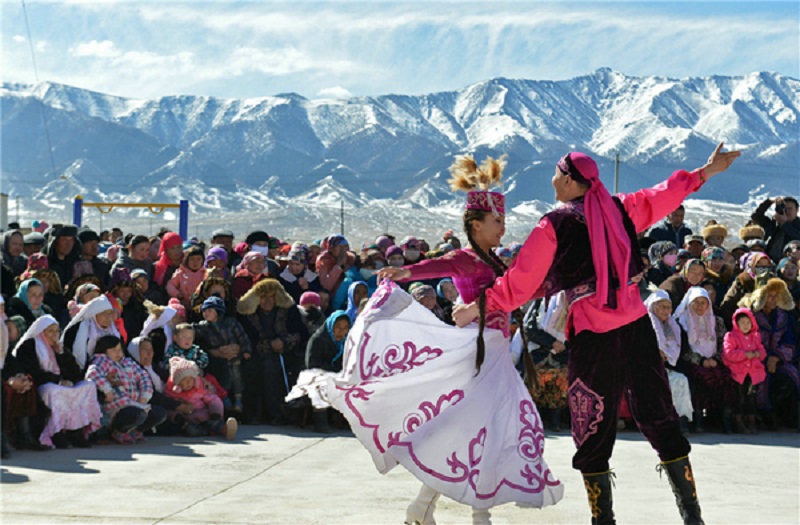Four Xinjiang festivals for travelers

The Xinjiang Uygur autonomous region in Northwest China is home to not only impressive landscapes but also a mix of unique festivals related to Islamic belief and its diverse ethnic groups. If you want to explore the region's vibrant tapestry of traditions and customs in full, save your date and plan your trip during one of the following festivals.
1. The Corban Festival (Eid al-Adha)
Also called the Sacrifice Festival, the Corban Festival is the second of the two main festivals Muslims celebrate alongside Eid al-Fitr. The celebration centers around a large feast as Muslim families slaughter lambs to share with the family, neighbors, and the poor, showcasing Muslims' mutual aid, courtesy, and friendship.
It falls on the 10th of the 12th and final month of the Islamic lunar calendar, which dictates the dates of Islamic holidays. In 2025, the festival falls on June 6 and the public holiday in Xinjiang will be from June 6 and 10.
You can witness thousands of worshippers gathering for sunrise prayers (arrive by 6 AM for the best view) at major mosques such as the Id Kah Mosque in Kashgar and the Tata'er Temple in Urumqi. You can also head to local markets to see butchers demonstrate halal techniques. There will be grand street celebrations marked by folk singing and dancing for tourists to watch and join. Some guesthouses or homestays may invite tourists to share the feast—try freshly grilled kebabs, pilaf, and beshbarmak (Kazak boiled meat dish).
2. The Rouzi Festival (Eid al-Fitr)
The Rouzi Festival (Eid al-Fitr), falling on the first day of the tenth month of the Islamic calendar, marks the end of the month-long dawn-to-dusk fasting of Ramadan.
In 2025, the festival fell on March 31, and in 2026, it will fall on March 20.
In addition to witnessing sunrise prayer gatherings at iconic mosques, tourists can watch the hypnotic Sufi-inspired Samah dance at Kashgar's Id Kah Square, the eagle dances and horseback games staged by Kazak families in Yining, and sample traditional foods like samsa (baked meat pies), nang (flatbread), and sangza (hand-pulled noodles deep fried in oil and twisted into a pyramid shape) as well as a wide range of sweet treats unique to the region. If you're lucky, some Uygur or Kazak families may invite you to share iftar (breaking fast meal).
Popular bazaars such as the Kashgar Sunday Bazaar and the Urumqi Grand Bazaar are in full swing at this time of year, enabling tourists to immerse themselves in festivities and shop for souvenirs and handicrafts.
3. Nowruz
Nowruz, meaning "new day" in Persian, occurs on the Spring Equinox, March 21 on the Georgian calendar. Also known as the Persian New Year observed by more than 300 million people worldwide, Nowruz is marked by ethnic groups including Uygurs, Kazaks, and Tajiks in Xinjiang. In 2009, the International Day of Nowruz was inscribed on the Representative List of the Intangible Cultural Heritage of Humanity.
Nowruz celebrations include a variety of rituals, ceremonies, traditional games, special dishes, performances, and other cultural events which take place for around two weeks. For tourists, unmissable Nowruz experiences include eating the hearty Nowruz stew (a porridge-like dish of more than 20 ingredients including lamb, lentils, and vegetables), watching wrestling and horse races in places such as Turpan and Hotan, and participating in bonfire jumping, purification ritual in rural areas such as the Yili Valley.
4. The Turpan Grape Festival
Launched in 1990, the Turpan Grape Festival is held annually in mid-to-late August and lasts three to four days. With its dry and sunny climate, Turpan has a long history of growing grapes and is one of the main grape production bases in China. Its planting area totals 42,000 hectares with 550 grape varieties.
To partake in the grape harvest celebrations, you can join vineyard tours by strolling through the famed Grape Valley and picking fresh grapes under shaded trellises. Or you can go on a Flame Mountain vineyard hike to enjoy the unique fusion of desert and grapevines, ending with a sunset picnic. Other fun activities include joining locals in sun-drying grapes on adobe racks, sampling grape-based delicacies to your heart's content, and trying the popular sand therapy.
In addition, you shouldn't miss the open-air concerts featuring UNESCO-listed Twelve Muqam melodies, often held in vineyards, and explore the Karez well system to learn about Turpan's ancient underground irrigation channels.
(Source from China Daily)